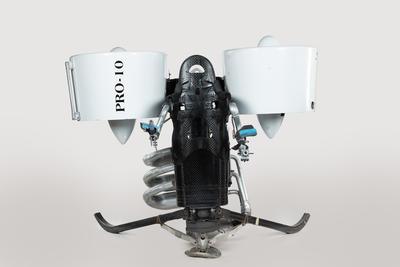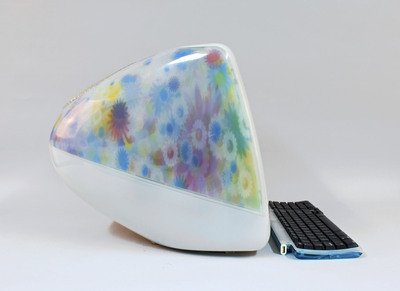Jetpack [Martin Prototype N10]
Maker and role
Martin Aircraft Company, Constructor
Production date
2006
See full details
Object detail
Accession number
2021.56
Maker
Production period
Description
Martin Prototype N10 Jetpack.
The jetpack consists of two large white ducted-fans, "PRO-10" printed in black on the proper right side. The right side has two silver handle bars, the left has one. One of the handle bars on the right has "R" hand-written in blue pen. The left ducted-fan has black duct tape on the bottom of the fan.
Between the ducted-fans is the body of the jetpack, consisting of the fuel tank and engine. The fuel tank and back rest are made from carbon fibre elements with a black-checkered pattern. The fuel tank has a silver fuel cap, and rests on two carbon fibre skis, black foam padding and a circular metal disk which acts as the main landing gear. The proper right ski has "4" handwritten in white, the left has "3".
The backrest extends out between the middle of the fans, with foam padded armrests. Each arm has an incomplete metal joystick, with foam, plastic, wiring and rope elements. A small, metal attachment reads, "IDEAL". On the backrest interior is a white sticker with a black table which reads, "Pilot Weight Seat Position Rods / Glenn 102 132? / Colin 78.8 16? / Ray 78.2 16? / Bill 92 47 / Ed 74 0? / Dean 87 ? / Harrison -10? / Vanessa -27?" printed in black. Various measurements are recorded in blue pen, some illegible, "830 835 / 10 / 10 / [?] / [?] / [?] / [?] / 70 -25 976 979".
Attached to the rear of the jetpack is the engine. This is secured with black and white zipties, bolts and a red fabric strap. The top of the engine is covered in a black carbon fibre casing, with "Bill 36 at Top" handwritten in blue pen. "DO NOT USE U/S" is hand-written in yellow along a belt which connects to the ducted-fans. Below this is two carbon fibre rods which adjust the settings for the backrest. "Bill" and two blue lines are hand-drawn in blue pen on the ends of the rods.
Beneath this is the silver metal engine, which runs adjacent to the fuel tank. "CRANK / SHOP / MADE IN USA" is embossed on the top of the engine. "GNM / 1000" is engraved down the length of the engine, and "SFS / 10.9" is embossed on each bolt. Connected to the front of the engine are various tubes with blue and black caps, each with "NGK / TB05EM" or "NGK / TB05EMA" embossed. A piece of masking tape stuck to the engine has "3" hand-written in blue. The engine is attached to a vertical rectangular tube made of carbon fibre. "052 / 71/95mm" is etched onto the silver rim. Attached to the top is a black filter with "K&N" repeated around the edges.
Down the proper left-hand side is various connecting tubes, with small metal attachments reading, "ALL 300 SS / TRIDON / AUSTRALIA". A small red cap on top of a metal tube reads, "CAPLUGS / CD-6".
On the right side proper is "98 / 681089 / ROTAX / 97 / 12 / 1965 / ROTAX / 810402" embossed down the side of the engine, with "21.0817" printed in white. Three black caps read, "ROTAX / RAVE". Three large silver cylinders connected to the engine with zipties and bolts, run down to a muffler and exhaust cylinder.
At the bottom of the engine are various bits of loose wiring. A black maker's plate for the engine is attached, "BOMBARDIER - ROTAX GMHB, GUNSKIRCHEN / Mot. Nr. M5319720 / bore: 3 x 70,50 mm, stroke:68 mm, capac: 796,3 c.c. / TYPE 809 MADE IN AUSTRALIA". Next to this is a black plastic handle which is pulled to start the engine.
The jetpack consists of two large white ducted-fans, "PRO-10" printed in black on the proper right side. The right side has two silver handle bars, the left has one. One of the handle bars on the right has "R" hand-written in blue pen. The left ducted-fan has black duct tape on the bottom of the fan.
Between the ducted-fans is the body of the jetpack, consisting of the fuel tank and engine. The fuel tank and back rest are made from carbon fibre elements with a black-checkered pattern. The fuel tank has a silver fuel cap, and rests on two carbon fibre skis, black foam padding and a circular metal disk which acts as the main landing gear. The proper right ski has "4" handwritten in white, the left has "3".
The backrest extends out between the middle of the fans, with foam padded armrests. Each arm has an incomplete metal joystick, with foam, plastic, wiring and rope elements. A small, metal attachment reads, "IDEAL". On the backrest interior is a white sticker with a black table which reads, "Pilot Weight Seat Position Rods / Glenn 102 132? / Colin 78.8 16? / Ray 78.2 16? / Bill 92 47 / Ed 74 0? / Dean 87 ? / Harrison -10? / Vanessa -27?" printed in black. Various measurements are recorded in blue pen, some illegible, "830 835 / 10 / 10 / [?] / [?] / [?] / [?] / 70 -25 976 979".
Attached to the rear of the jetpack is the engine. This is secured with black and white zipties, bolts and a red fabric strap. The top of the engine is covered in a black carbon fibre casing, with "Bill 36 at Top" handwritten in blue pen. "DO NOT USE U/S" is hand-written in yellow along a belt which connects to the ducted-fans. Below this is two carbon fibre rods which adjust the settings for the backrest. "Bill" and two blue lines are hand-drawn in blue pen on the ends of the rods.
Beneath this is the silver metal engine, which runs adjacent to the fuel tank. "CRANK / SHOP / MADE IN USA" is embossed on the top of the engine. "GNM / 1000" is engraved down the length of the engine, and "SFS / 10.9" is embossed on each bolt. Connected to the front of the engine are various tubes with blue and black caps, each with "NGK / TB05EM" or "NGK / TB05EMA" embossed. A piece of masking tape stuck to the engine has "3" hand-written in blue. The engine is attached to a vertical rectangular tube made of carbon fibre. "052 / 71/95mm" is etched onto the silver rim. Attached to the top is a black filter with "K&N" repeated around the edges.
Down the proper left-hand side is various connecting tubes, with small metal attachments reading, "ALL 300 SS / TRIDON / AUSTRALIA". A small red cap on top of a metal tube reads, "CAPLUGS / CD-6".
On the right side proper is "98 / 681089 / ROTAX / 97 / 12 / 1965 / ROTAX / 810402" embossed down the side of the engine, with "21.0817" printed in white. Three black caps read, "ROTAX / RAVE". Three large silver cylinders connected to the engine with zipties and bolts, run down to a muffler and exhaust cylinder.
At the bottom of the engine are various bits of loose wiring. A black maker's plate for the engine is attached, "BOMBARDIER - ROTAX GMHB, GUNSKIRCHEN / Mot. Nr. M5319720 / bore: 3 x 70,50 mm, stroke:68 mm, capac: 796,3 c.c. / TYPE 809 MADE IN AUSTRALIA". Next to this is a black plastic handle which is pulled to start the engine.
Brief History
The Prototype N10 Jetpack was built in November 2006 in Christchurch by the Martin Aircraft Company (MAC), founded by Glenn Martin in 1998. It is one of several jetpacks developed by the company in the pursuit of creating a marketable jetpack. Martin wanted to develop a product more competitive and practical than the earlier developed rocket belt, which was limited by the short bursts of flight time it could achieve using rocket powered non-combustion gas.
The idea behind the MAC jetpack was for a vertical take-off and landing (VTOL) device that people could fly without the cost or training required to obtain a pilot’s licence. Martin’s application achieved lift using belt-driven ducted fans that were powered by a petrol engine connected to a driveshaft. This formed the basis of the propulsion unit for the different models of jetpacks that were developed between 1998 and 2019.
The idea behind the MAC jetpack was for a vertical take-off and landing (VTOL) device that people could fly without the cost or training required to obtain a pilot’s licence. Martin’s application achieved lift using belt-driven ducted fans that were powered by a petrol engine connected to a driveshaft. This formed the basis of the propulsion unit for the different models of jetpacks that were developed between 1998 and 2019.
Marks
PRO-10 Printed
R Hand-written
4 Hand-written
3 Hand-written
IDEAL Embossed
Pilot Weight Seat Position Rods / Glenn 102 132? / Colin 78.8 16? / Ray 78.2 16? / Bill 92 47 / Ed 74 0? / Dean 87 ? / Harrison -10? / Vanessa -27? Printed
830 835 / 10 / 10 / [?] / [?] / [?] / [?] / 70 -25 976 979 Hand-written
Bill 36 at Top Hand-written
DO NOT USE U/S Hand-written
Bill Hand-written
CRANK / SHOP / MADE IN USA Embossed
GNM / 1000 Engraved
SFS / 10.9 Embossed
NGK / TB05EM Embossed
NGK / TB05EMA Embossed
3 Hand-written
052 / 71/95mm Embossed
K&N Embossed
ALL 300 SS / TRIDON / AUSTRALIA Embossed
CAPLUGS / CD-6 Embossed
98 / 681089 / ROTAX / 97 / 12 / 1965 / ROTAX / 810402 Embossed
21.0817 Printed
ROTAX / RAVE Embossed
BOMBARDIER - ROTAX GMHB, GUNSKIRCHEN / Mot. Nr. M5319720 / bore: 3 x 70,50 mm, stroke:68 mm, capac: 796,3 c.c. / TYPE 809 MADE IN AUSTRALIA Maker's Plate
R Hand-written
4 Hand-written
3 Hand-written
IDEAL Embossed
Pilot Weight Seat Position Rods / Glenn 102 132? / Colin 78.8 16? / Ray 78.2 16? / Bill 92 47 / Ed 74 0? / Dean 87 ? / Harrison -10? / Vanessa -27? Printed
830 835 / 10 / 10 / [?] / [?] / [?] / [?] / 70 -25 976 979 Hand-written
Bill 36 at Top Hand-written
DO NOT USE U/S Hand-written
Bill Hand-written
CRANK / SHOP / MADE IN USA Embossed
GNM / 1000 Engraved
SFS / 10.9 Embossed
NGK / TB05EM Embossed
NGK / TB05EMA Embossed
3 Hand-written
052 / 71/95mm Embossed
K&N Embossed
ALL 300 SS / TRIDON / AUSTRALIA Embossed
CAPLUGS / CD-6 Embossed
98 / 681089 / ROTAX / 97 / 12 / 1965 / ROTAX / 810402 Embossed
21.0817 Printed
ROTAX / RAVE Embossed
BOMBARDIER - ROTAX GMHB, GUNSKIRCHEN / Mot. Nr. M5319720 / bore: 3 x 70,50 mm, stroke:68 mm, capac: 796,3 c.c. / TYPE 809 MADE IN AUSTRALIA Maker's Plate
Media/Materials
Other name
Jet Pack
Collection
Credit Line
Martin Aircraft Company. 2006. Jetpack [Martin Prototype N10], 2021.56. The Museum of Transport and Technology (MOTAT).



![Mug [Martin Jetpack]; Martin Aircraft Company](https://collection.motat.nz/records/images/medium/54546/00f49b093e73030c4f69a96390733c42c559b458.jpg)
![Luggage Tag [Martin Jetpack]; Martin Aircraft Company](https://collection.motat.nz/records/images/medium/54557/3e30a05cae00dbb004cb7fd303aedb020234c55c.jpg)
![Patch [Martin Jetpack]; Martin Aircraft Company; Lukus Productions](https://collection.motat.nz/records/images/medium/54562/084a4d6d60d0c4994a20c8d5986eba1807fea895.jpg)
![Lanyard [Martin Jetpack]; Martin Aircraft Company](https://collection.motat.nz/records/images/medium/54567/0693bea4df875c8b2b1b14c8aa6067a55c24bc5c.jpg)
![Lanyard [Martin Jetpack]; Martin Aircraft Company](https://collection.motat.nz/records/images/medium/54569/b52a2ff20ccc6138b90df9e9895c229139b5f5da.jpg)
![Lanyard [Martin Jetpack]; Martin Aircraft Company](https://collection.motat.nz/records/images/medium/54571/6082fd2a0469d720c50f3a44b1209ed8f4290584.jpg)
Public comments
Be the first to comment on this object record.